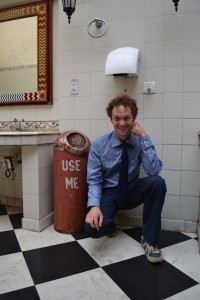On February 13 Nandan and I visited the Taj Mahal. The architecture and the building’s history are very interesting and many people have produced media about these things. I want to write about four problems I saw during that visit:
- Monument entry
- Boy beating
- Queue control
- Filthy grounds
I want to preface my stories by saying that for some reason, there happened to be a lot of people visiting the monument on the day I went. I have talked with other people who said that it is unusual for so many people to visit that there is a long queue to get inside.
Monument Entry
There was a very long line to get inside the monument grounds. Nandan and I watched the line for a few minutes then started walking to the end of it. It was moving slowly and after walking for about two minutes without coming to the end of the line we estimated that it would take us a minimum of thirty minutes to get inside. We had already bought tickets and we both knew that if we did not get inside, then when the monument closed for the day everyone in line would be turned away. We did not have time to visit another time. I felt pressured because it would not be easy for me to return to this city during this trip to India, or perhaps any other trip to India. I wanted to get in, but this also made me think about whether my ticket was refundable and I just knew that even though the ticket was only good on the day of purchase if anyone failed to gain entry after buying a ticket then I knew that the purchase price would not be returned.
Some boys had been bothering us saying that they worked with the police and that they could get us in. I had no idea what this meant, but it seemed like our only sure option for entry. My ticket cost Rs 750 and their price to get us to the front of the line was Rs 200. We agreed. The boy we hired went near the front of the line then jumped in line in front of an old lady who could not argue. After he was in line, he called us to get in line in front of him. Then he got out of line and asked for Rs 200. The police were watching. Nandan told me that he would give Rs 100 to the police. So that is how that works.
Boy beating
After getting inside the monument grounds we found that there was a line to get to the top tier of the monument. The layout is that there is a garden surrounding the building, then there is a lower base which one reaches by climbing a staircase from the garden. One may circle the monument by walking around the lower base, but to enter the building one must climb another staircase and enter from the top platform.
Nandan and I were on the lower base in queue to climb the staircase to reach the top level. There was a large queue on this day and we stood near a group of foreign people led by a guide. The guide cut the line near the front then moved all the foreign tourists and me and Nandan into a section which would soon be allowed the staircase.
The police were allowing groups of people to use the staircase. A certain number of people were already on the top level, and when they decided that enough people had descended by another staircase only for exiting, then they allowed a group of people to proceed up the entry stairs. So the line to get to the building was usually not moving.
It happened that everyone was in a cheerful mood because they were all about to get to visit India’s most famous monument. Someone started a crowd wave, wherein someone would cheer and maybe raise their hands, then the person in front of them would do the same, then the person in front of them would do the same, so that there was a wave of cheering and movement. I saw nothing wrong with this and I also participated in cheering. The people below in the garden could see this activity and the people above on the Taj level could look down on the crowd if they chose to do so, and in fact many people did to see the crowd and beautiful gardens below.
There were cops with machine guns everywhere. One of them did not like the cheering and started yelling that the crowd was being dangerous, and that there were women and children and old people present who could be trampled if the crowd began to run. I saw no danger of the crowd beginning to run. Several hundred people had participated in the cheering, but after yelling a bit the cop chose one boy who seemed the same as anyone else who cheered. This boy happened to be standing near me, and I think that if he had been doing anything unusual I would have noticed it because I had been looking in his general direction since before the cop was yelling.
It seemed to me that the policeman arbitrarily picked that boy from the crowd to set an example for everyone. This boy was about 23 years old, well-dressed in slacks and a button shirt, and seemed nice enough. The policeman started punching the boy until he fell on the ground and when he was on the ground he started kicking him. The boy tried to block the kicks with his hands but otherwise did not resist. After landing some good kicks the cop told the boy to stand up and the boy was cowering and making apologetic, trembling gestures. The cop then grabbed the boy roughly and took him away from the now silent crowd. The people around me were saying that after the police took all his money they would fine him more, beat him at the police station, then put him in jail.
India seems so proud of their Taj Mahal, and with tourism being such an important industry, how the Ministry of Tourism allow the police to openly exhibit such behavior in front of crowds of tourists? It is my opinion that the police officer probably thought that the crowd would be grateful for this or any other display of police power, as if foreign tourists traveled from far away to see what control the Indian government has over its people.
Queue control
In India people typically do not queue in line. If there is some point of interest which a large number of people must singly access, then rather than get in line and use the point on a first-come, first-served basis the dominant Indian instinct is that there is some amount of pushing and closeness to the point of interest which signifies being next in turn, and people who do not participate in the huddling face being cut in line.
Inside the Taj Mahal itself there are doorways which are intended for use by one person at a time, either entering or exiting. As typical in Indian crowds, the crowd favored the use of the door for simultaneous slow and stressful entry and exit by two people at once. At the same time that the door is being used at double capacity, the members of crowds on both sides of the door were jostling to become the next person to be able to use the door. Some old American ladies in a tour group were standing at the door totally confused about how to walk through it.

Lane Rasberry looking used next to an overused trashcan at Taj Majal
Their thought, as well as mine, was that if there was some kind of line control where a group of people was allowed to freely exit, then another group allowed to freely enter, then the line would move much more quickly plus everyone who visited the rooms could retain some dignity and not have to push for space like pigs fighting for position at a slop trough. One lady said, “The management here should learn about line control from Disneyland!”
Some place in India are to me a lot like a Disneyland where the visitors are allowed entry for the amusement of sociopathic cartoon characters.
Filthy grounds
Labor is cheap in India and a lot of people pay a lot of money to visit the Taj Mahal. Would it be so difficult to arrange for the restrooms to be cleaned once a month? Has this restroom been cleaned ever?
I am exaggerating. I am sure parts of the restroom have been cleaned at some point, but most of it was disgusting. It is representative of the management style at Indian monuments.

